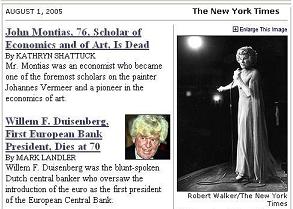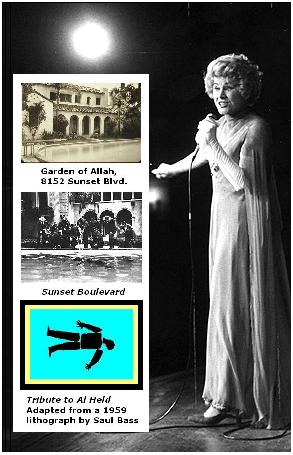Continued:
The Happy Ending Problem
From Google News this afternoon–

See also the previous entry.
From Google News this afternoon–

See also the previous entry.
| Date: Sun, 28 Aug 2005 12:30:40 -0400 From: Alf van der Poorten AM Subject: Vale George Szekeres and Esther Klein Szekeres Members of the Number Theory List will be sad to learn that George and Esther Szekeres both died this morning. George, 94, had been quite ill for the last 2-3 days, barely conscious, and died first at 06:30. Esther, 95, died a half hour later. Both George Szekeres and Esther Klein will be recalled by number theorists as members of the group of young Hungarian mathematicians of the 1930s including Turan and Erdos. George and Esther's coming to Australia in the late 40s played an important role in the invigoration of Australian Mathematics. George was also an expert in group theory and relativity; he was my PhD supervisor. Emeritus Professor |
AVE
| "Hello! Kinch here. Put me on to Edenville. Aleph, alpha: nought, nought, one."
"A very short space of time through very short times of space…. — James Joyce, Ulysses, Proteus chapter A very short space of time through very short times of space…. "It is demonstrated that space-time should possess a discrete structure on Planck scales." — Peter Szekeres, abstract of Discrete Space-Time |
Peter Szekeres is the son of George and Esther Szekeres.
"At present, such relationships can at best be heuristically described in terms that invoke some notion of an 'intelligent user standing outside the system.'"
— Gian-Carlo Rota in Indiscrete Thoughts, p. 152
Diamond Theorem Revisited
This evening I wrote a revised version of my 1979 “diamond theorem” abstract.
Part I: The 24-Cell
| From John Baez, “This Week’s Finds in Mathematical Physics (Week 198),” September 6, 2003: Noam Elkies writes to John Baez:
The enrapturing discoveries of our field systematically conceal, like footprints erased in the sand, the analogical train of thought that is the authentic life of mathematics – Gian-Carlo Rota |
Like footprints erased in the sand….
“Hello! Kinch here. Put me on to Edenville. Aleph, alpha: nought, nought, one.”
“A very short space of time through very short times of space….
Am I walking into eternity along Sandymount strand?”
— James Joyce, Ulysses, Proteus chapter
A very short space of time through very short times of space….
“It is demonstrated that space-time should possess a discrete structure on Planck scales.”
— Peter Szekeres, abstract of Discrete Space-Time
“A theory…. predicts that space and time are indeed made of discrete pieces.”
— Lee Smolin in Atoms of Space and Time (pdf), Scientific American, Jan. 2004
“… a fundamental discreteness of spacetime seems to be a prediction of the theory….”
— Thomas Thiemann, abstract of Introduction to Modern Canonical Quantum General Relativity
“Theories of discrete space-time structure are being studied from a variety of perspectives.”
— Quantum Gravity and the Foundations of Quantum Mechanics at Imperial College, London
The above speculations by physicists
are offered as curiosities.
I have no idea whether
any of them are correct.
Related material:
Stephen Wolfram offers a brief
History of Discrete Space.
For a discussion of space as discrete
by a non-physicist, see John Bigelow‘s
Space and Timaeus.

High Concept, continued:
“In the beginning there was nothing.
And God said, ‘Let there be light!’
And there was still nothing,
but now you could see it.“
— Jim Holt, Big-Bang Theology,
Slate‘s “High Concept” department
Related material:
| Page 110:
“In chapter I I explained that devils first and foremost exist as semioticians of the world’s signs. Devils solely live in their interpretations, in their destructive syllogisms. As Visconti puts it, devils speak the idiom of the mind.37 …. The exorcist’s healing voice states that Satan has always been absent from the world, that his disturbing and unclear manifestations in the possessed person’s physicality are really nonexistent occurrences, nothing but disturbances of the mind, since evil itself is a lack of being.” Footnote 37, page 110: “It is necessary to distinguish the devils’ ‘language of the mind’ and Augustine’s verbum mentis (word of the mind), as he theorizes it first of all in On the Trinity (book 15). The devils’ language of the mind disturbs the subject’s internal and preverbal discourse.” |
1:06:55
PM
"I had an epiphany."
— Apostolos Doxiadis
Related material:
Log24 March 11:
Lucas Promises a
Darker Star Wars
High Concept*
"Concept (scholastics' verbum mentis)–
theological analogy of Son's procession
as Verbum Patris, 111-12"
— index to Joyce and Aquinas,
by William T. Noon, S.J.,
Yale University Press 1957,
second printing 1963, page 162
"So did God cause the big bang? Overcome by metaphysical lassitude, I finally reach over to my bookshelf for The Devil's Bible. Turning to Genesis I read: 'In the beginning there was nothing. And God said, 'Let there be light!' And there was still nothing, but now you could see it.'"
Related material:
Nothing Ventured,
The God-Shaped Hole, and
Is Nothing Sacred?
* See also John O'Callaghan, Thomistic Realism and the Linguistic Turn: Toward a More Perfect Form of Existence, (University of Notre Dame Press, 2003) and Joshua P. Hochschild, "Does Mental Language Imply Mental Representationalism? The Case of Aquinas’s Verbum Mentis," Proceedings of the Society for Medieval Logic and Metaphysics, Volume 4, 2004 (pdf), pp. 12-17.
Apostolos Doxiadis on last month's conference on "mathematics and narrative"–
Doxiadis is describing how talks by two noted mathematicians were related to
"… a sense of a 'general theory bubbling up' at the meeting… a general theory of the deeper relationship of mathematics to narrative…. "
Doxiadis says both talks had "a big hole in the middle."
"Both began by saying something like: 'I believe there is an important connection between story and mathematical thinking. So, my talk has two parts. [In one part] I’ll tell you a few things about proofs. [And in the other part] I’ll tell you about stories.' …. And in both talks it was in fact implied by a variation of the post hoc propter hoc, the principle of consecutiveness implying causality, that the two parts of the lectures were intimately related, the one somehow led directly to the other."
"And the hole?"
"This was exactly at the point of the link… [connecting math and narrative]… There is this very well-known Sidney Harris cartoon… where two huge arrays of formulas on a blackboard are connected by the sentence ‘THEN A MIRACLE OCCURS.’ And one of the two mathematicians standing before it points at this and tells the other: ‘I think you should be more explicit here at step two.’ Both… talks were one half fascinating expositions of lay narratology– in fact, I was exhilarated to hear the two most purely narratological talks at the meeting coming from number theorists!– and one half a discussion of a purely mathematical kind, the two parts separated by a conjunction roughly synonymous to ‘this is very similar to this.’ But the similarity was not clearly explained: the hole, you see, the ‘miracle.’ Of course, both [speakers]… are brilliant men, and honest too, and so they were very clear about the location of the hole, they did not try to fool us by saying that there was no hole where there was one."
"At times, bullshit can only be countered with superior bullshit."
— Norman Mailer
Many Worlds and Possible Worlds in Literature and Art, in Wikipedia:
"The concept of possible worlds dates back to a least Leibniz who in his Théodicée tries to justify the apparent imperfections of the world by claiming that it is optimal among all possible worlds. Voltaire satirized this view in his picaresque novel Candide….
Borges' seminal short story El jardín de senderos que se bifurcan ("The Garden of Forking Paths") is an early example of many worlds in fiction."
Background:
Modal Logic in Wikipedia
Possible Worlds in Wikipedia
Possible-Worlds Theory, by Marie-Laure Ryan
(entry for The Routledge Encyclopedia of Narrative Theory)
— Many Dimensions, by Charles Williams, 1931 (Eerdmans paperback, April 1979, pp. 43-44)
— Aion, by C. G. Jung, 1951 (Princeton paperback, 1979, p. 236)
"Its discoverer was of the opinion that he had produced the equivalent of the primordial protomatter which exploded into the Universe."
|
"We symbolize
logical necessity with the box and logical possibility with the diamond
"The possibilia that exist,
— Michael Sudduth, |
|
Representing truth:
Rebecca Goldstein |
Representing bullshit:
Apostolos Doxiadis |
| Goldstein’s truth:
Gödel was a Platonist who believed in objective truth. See Rothstein’s review of Goldstein’s new book Incompleteness. |
Doxiadis’s bullshit:
Gödel, along with Darwin, Marx, Nietzsche, Freud, Einstein, and Heisenberg, destroyed a tradition of certainty that began with Plato and Euclid. |
“Examples are the stained-glass
windows of knowledge.” — Nabokov
Mathematics and Narrative
continued
"There is a pleasantly discursive treatment of Pontius Pilate's unanswered question 'What is truth?'"
— H. S. M. Coxeter, 1987, introduction to Richard J. Trudeau's remarks on the "Story Theory" of truth as opposed to the "Diamond Theory" of truth " in The Non-Euclidean Revolution
"I had an epiphany: I thought 'Oh my God, this is it! People are talking about elliptic curves and of course they think they are talking mathematics. But are they really? Or are they talking about stories?'"
— An organizer of last month's "Mathematics and Narrative" conference
"A new epistemology is emerging to replace the Diamond Theory of truth. I will call it the 'Story Theory' of truth: There are no diamonds. People make up stories about what they experience. Stories that catch on are called 'true.' The Story Theory of truth is itself a story that is catching on. It is being told and retold, with increasing frequency, by thinkers of many stripes*…."
— Richard J. Trudeau in The Non-Euclidean Revolution
"'Deniers' of truth… insist that each of us is trapped in his own point of view; we make up stories about the world and, in an exercise of power, try to impose them on others."
— Jim Holt in this week's New Yorker magazine. Click on the box below.

* Many stripes —
"What disciplines were represented at the meeting?"
"Apart from historians, you mean? Oh, many: writers, artists, philosophers, semioticians, cognitive psychologists – you name it."
— An organizer of last month's "Mathematics and Narrative" conference

— Todd S. Purdum in today’s New York Times
Part I: The Light
The Shining of May 29
and
Diamond Theory
Part II: The Darkness

“The Game was at first nothing more than a witty method for developing memory and ingenuity among students and musicians.
The inventor, Bastian Perrot of Calw… found that the pupils at the Cologne Seminary had a rather elaborate game they used to play. One would call out, in the standardized abbreviations of their science, motifs or initial bars of classical compositions, whereupon the other had to respond with the continuation of the piece, or better still with a higher or lower voice, a contrasting theme, and so forth. It was an exercise in memory and improvisation quite similar to the sort of thing probably in vogue among the ardent pupils of counterpoint in the days of Schütz, Pachelbel, and Bach….
Bastian Perrot… constructed a frame, modeled on a child’s abacus, a frame with several dozen wires on which could be strung glass beads of various sizes, shapes, and colors….”
Narrative and Latin Squares
From The Independent, 15 August 2005:
“Millions of people now enjoy Sudoku puzzles. Forget the pseudo-Japanese baloney: sudoku grids are a version of the Latin Square created by the great Swiss mathematician Leonhard Euler in the late 18th century.”
The Independent was discussing the conference on “Mathematics and Narrative” at Mykonos in July.
From the Wikipedia article on Latin squares:
“The popular Sudoku puzzles are a special case of Latin squares; any solution to a Sudoku puzzle is a Latin square. Sudoku imposes the additional restriction that 3×3 subgroups must also contain the digits 1–9 (in the standard version).
The Diamond 16 Puzzle illustrates a generalized concept of Latin-square orthogonality: that of “orthogonal squares” (Diamond Theory, 1976) or “orthogonal matrices”– orthogonal, that is, in a combinatorial, not a linear-algebra sense (A. E. Brouwer, 1991).”
This last paragraph, added to Wikipedia on Aug. 14, may or may not survive the critics there.
Kaleidoscope, continued:
Austere Geometry
From Noel Gray, The Kaleidoscope: Shake, Rattle, and Roll:
“… what we will be considering is how the ongoing production of meaning can generate a tremor in the stability of the initial theoretical frame of this instrument; a frame informed by geometry’s long tradition of privileging the conceptual ground over and above its visual manifestation. And to consider also how the possibility of a seemingly unproblematic correspondence between the ground and its extrapolation, between geometric theory and its applied images, is intimately dependent upon the control of the truth status ascribed to the image by the generative theory. This status in traditional geometry has been consistently understood as that of the graphic ancilla– a maieutic force, in the Socratic sense of that term– an ancilla to lawful principles; principles that have, traditionally speaking, their primary expression in the purity of geometric idealities.* It follows that the possibility of installing a tremor in this tradition by understanding the kaleidoscope’s images as announcing more than the mere subordination to geometry’s theory– yet an announcement that is still in a sense able to leave in place this self-same tradition– such a possibility must duly excite our attention and interest.
* I refer here to Plato’s utilisation in the Meno of graphic austerity as the tool to bring to the surface, literally and figuratively, the inherent presence of geometry in the mind of the slave.”
See also
Noel Gray, Ph.D. thesis, U. of Sydney, Dept. of Art History and Theory, 1994:
“The Image of Geometry: Persistence qua Austerity– Cacography and The Truth to Space.”
Kaleidoscope, continued:
In Derrida’s Defense
The previous entry quoted an attack on Jacques Derrida for ignoring the “kaleidoscope” metaphor of Claude Levi-Strauss. Here is a quote by Derrida himself:
“The time for reflection is also the chance for turning back on the very conditions of reflection, in all the senses of that word, as if with the help of an optical device one could finally see sight, could not only view the natural landscape, the city, the bridge and the abyss, but could view viewing. (1983:19)
— Derrida, J. (1983) ‘The Principle of Reason: The University in the Eyes of its Pupils’, Diacritics 13.3: 3-20.”
The above quotation comes from Simon Wortham, who thinks the “optical device” of Derrida is a mirror. The same quotation appears in Desiring Dualisms at thispublicaddress.com, where the “optical device” is interpreted as a kaleidoscope.
Derrida’s “optical device” may (for university pupils desperately seeking an essay topic) be compared with Joyce’s “collideorscape.” For a different connection with Derrida, see The ‘Collideorscape’ as Différance.
Kaleidoscope
A new web page simplifies the Diamond 16 Puzzle and relates the resulting “kaleidoscope” to Hesse’s Bead Game.

For details, see
The Da Vinci Code
and Symbology at Harvard.
The Rev. Dr. Theodore Alexander Gill Sr., a Presbyterian theologian, a philosophy teacher, and an influential provost emeritus of John Jay College of Criminal Justice in Manhattan, died at 85 on June 10 in Princeton. In retirement from John Jay, The Rev. Dr. Gill was theologian in residence at Nassau Presbyterian Church in Princeton.
In memory of The Rev. Dr. Gill:
Religious Symbolism at Princeton
(on Nassau Presbyterian Church),
Pro-Semitism
(on number theory at Princeton),
For the Mad Musicians of Princeton,
(on Schroeder and Bernstein),
Movie Date and its preceding entries
(on Princeton’s St. John von Neumann),
Why Me?
(for Princeton theologian Elaine Pagels),
Notes on Literary and Philosophical Puzzles
(Princeton’s John Nash as Ya Ya Fontana), and
Go Tigers!
(for the Princeton Evangelical Fellowship).
The Fugue
"True joy is a profound remembering, and true grief is the same.
Thus it was, when the dust storm that had snatched Cal up finally died, and he opened his eyes to see the Fugue spread out before him, he felt as though the few fragile moments of epiphany he'd tasted in his twenty-six years– tasted but always lost– were here redeemed and wed. He'd grasped fragments of this delight before. Heard rumour of it in the womb-dream and the dream of love; known it in lullabies. But never, until now, the whole, the thing entire.
It would be, he idly thought, a fine time to die.
And a finer time still to live, with so much laid out before him."
Weaveworld,
Book Three:
Out of the
Empty Quarter
"The wheels of its body rolled,
the visible mathematics
of its essence turning on itself…."

For the meaning
of this picture, see
Geometry of the
4×4 Square.
For graphic designs
based on this geometry,
see Theme and Variations
and Diamond Theory.
For these designs in the
context of a Bach fugue,
see Timothy A. Smith's
essay (pdf) on
Fugue No. 21 in B-Flat Major
from Book II of
The Well-Tempered Clavier
by Johann Sebastian Bach.
Smith also offers a
Shockwave movie
that uses diamond theory
to illustrate this fugue.
A Miniature
Rosetta Stone

John Baez discussed (Sept. 6, 2003) the analogies of Weil, and he himself furnished another such Rosetta stone on a much smaller scale:
“… a 24-element group called the ‘binary tetrahedral group,’ a 24-element group called ‘SL(2,Z/3),’ and the vertices of a regular polytope in 4 dimensions called the ’24-cell.’ The most important fact is that these are all the same thing!”
For further details, see Wikipedia on the 24-cell, on special linear groups, and on Hurwitz quaternions,
The group SL(2,Z/3), also known as “SL(2,3),” is of course derived from the general linear group GL(2,3). For the relationship of this group to the quaternions, see the Log24 entry for August 4 (the birthdate of the discoverer of quaternions, Sir William Rowan Hamilton).
The 3×3 square shown above may, as my August 4 entry indicates, be used to picture the quaternions and, more generally, the 48-element group GL(2,3). It may therefore be regarded as the structure underlying the miniature Rosetta stone described by Baez.
“The typical example of a finite group is GL(n,q), the general linear group of n dimensions over the field with q elements. The student who is introduced to the subject with other examples is being completely misled.”
— J. L. Alperin, book review,
Bulletin (New Series) of the American
Mathematical Society 10 (1984), 121
“Jesus hits like
an atom bomb.“

Click on picture
for a sound clip.
For Sir Alec
From Elegance:
"Philosophers ponder the idea of identity: what it is to give something a name on Monday and have it respond to that name on Friday…."
— Bernard Holland, page C12,
The New York Times,
Monday, May 20, 1996.
Holland was pondering the identity of the Juilliard String Quartet, which had just given a series of concerts celebrating its fiftieth anniversary.
"Elegant"
— Page one,
The New York Times,
Monday, August 7, 2000.
The Times was describing the work of Sir Alec Guinness, who died on 8/5/00.
An example of the Holland name problem:
Monday, August 1, 2005 — Visible Mathematics:
"Earlier, there had been mapping projects in Saudi Arabia's Rub' al-Khali, the Empty Quarter in the south and west of the country….
'"Empty" is a misnomer… the Rub' al-Khali contains many hidden riches.'"
Friday, August 5, 2005 —

Related material:
Today's mathematical birthdays:
Saunders Mac Lane, John Venn,
and Sir William Rowan Hamilton.
It is well known that the quaternion group is a subgroup of GL(2,3), the general linear group on the 2-space over GF(3), the 3-element Galois field.
The figures below illustrate this fact.

Related material: Visualizing GL(2,p)
— J. L. Alperin, book review,
Bulletin (New Series) of the American
Mathematical Society 10 (1984), 121
Epiphany Term
“In Epiphany Term, 1942, C.S. Lewis delivered the Riddell Memorial Lectures… in…. the University of Durham…. He delivered three lectures entitled ‘Men without Chests,’ ‘The Way,’ and ‘The Abolition of Man.’ In them he set out to attack and confute what he saw as the errors of his age. He started by quoting some fashionable lunacy from an educationalists’ textbook, from which he developed a general attack on moral subjectivism. In his second lecture he argued against various contemporary isms, which purported to replace traditional objective morality. His final lecture, ‘The Abolition of Man,’ which also provided the title of the book published the following year, was a sustained attack on hard-line scientific anti-humanism. The intervening fifty years have largely vindicated Lewis.”
— J. R. Lucas, The Restoration of Man
Pictured:
Modal Theology
|
By SALAH NASRAWI
The Associated Press Tuesday, August 2, 2005 9:50 AM EDT RIYADH, Saudi Arabia — Muslim leaders and Saudi princes bade farewell to King Fahd on Tuesday, saying prayers in a packed Riyadh mosque and then burying him in an unmarked desert grave in keeping with the kingdom’s austere version of Islam. |
"What is it, Major Lawrence,
that attracts you personally
to the desert?"
"It's clean."
Visible Mathematics,
continued —
"The Garden of Eden is behind us
and there is no road
back to innocence;
we can only go forward."
— Anne Morrow Lindbergh,
Earth Shine, p. xii
— Werner Heisenberg,
"Die Bedeutung des Schönen
in der exakten Naturwissenschaft,"
address delivered to the
Bavarian Academy of Fine Arts,
Munich, 9 Oct. 1970, reprinted in
Heisenberg's Across the Frontiers,
translated by Peter Heath,
Harper & Row, 1974
Related material:
(in Arabic, ka'b)
and
Final Arrangements, continued
If I stand starry-eyed
That's a danger in paradise
For mortals who stand beside
An angel like you.
— Robert Wright and George Forrest

Memorial: at the
Wallace Stevens
Concordance,
enter center.
Final Arrangements, continued

From today’s New York Times:
“BERLIN, July 31 – Willem F. Duisenberg, the blunt-spoken Dutch central banker who oversaw the introduction of the euro as the first president of the European Central Bank, was found dead on Sunday in a swimming pool at his villa in the south of France….”

Flashback to July 29,
Anatomy of a Death
"Earlier, there had been mapping projects in Saudi Arabia's Rub' al-Khali, the Empty Quarter in the south and west of the country….
'"Empty" is a misnomer… the Rub' al-Khali contains many hidden riches.'"
— Maps from the Sky,
Saudi Aramco World, March/April 1995
|
From Weaveworld
Book Three: |
Powered by WordPress